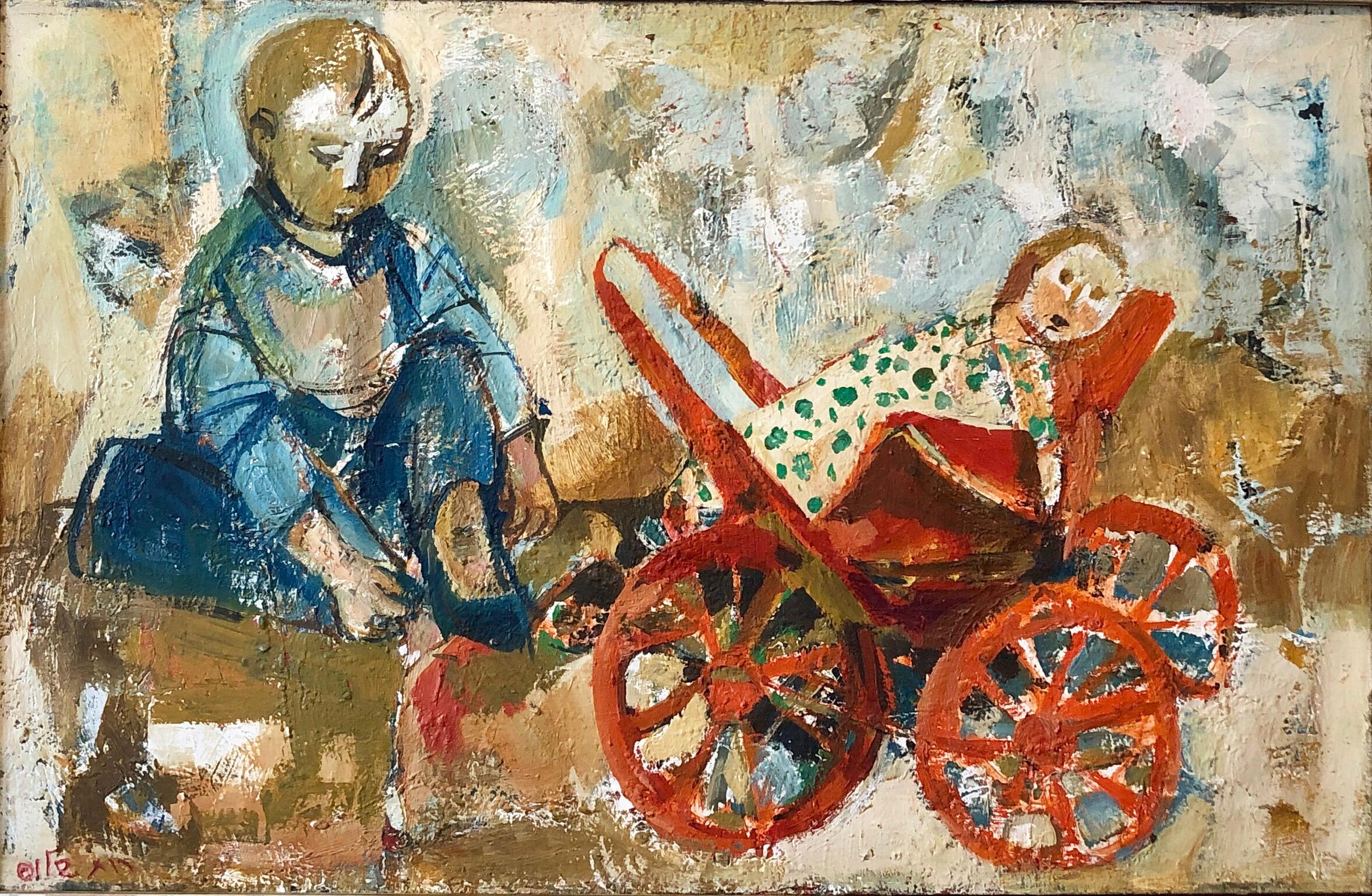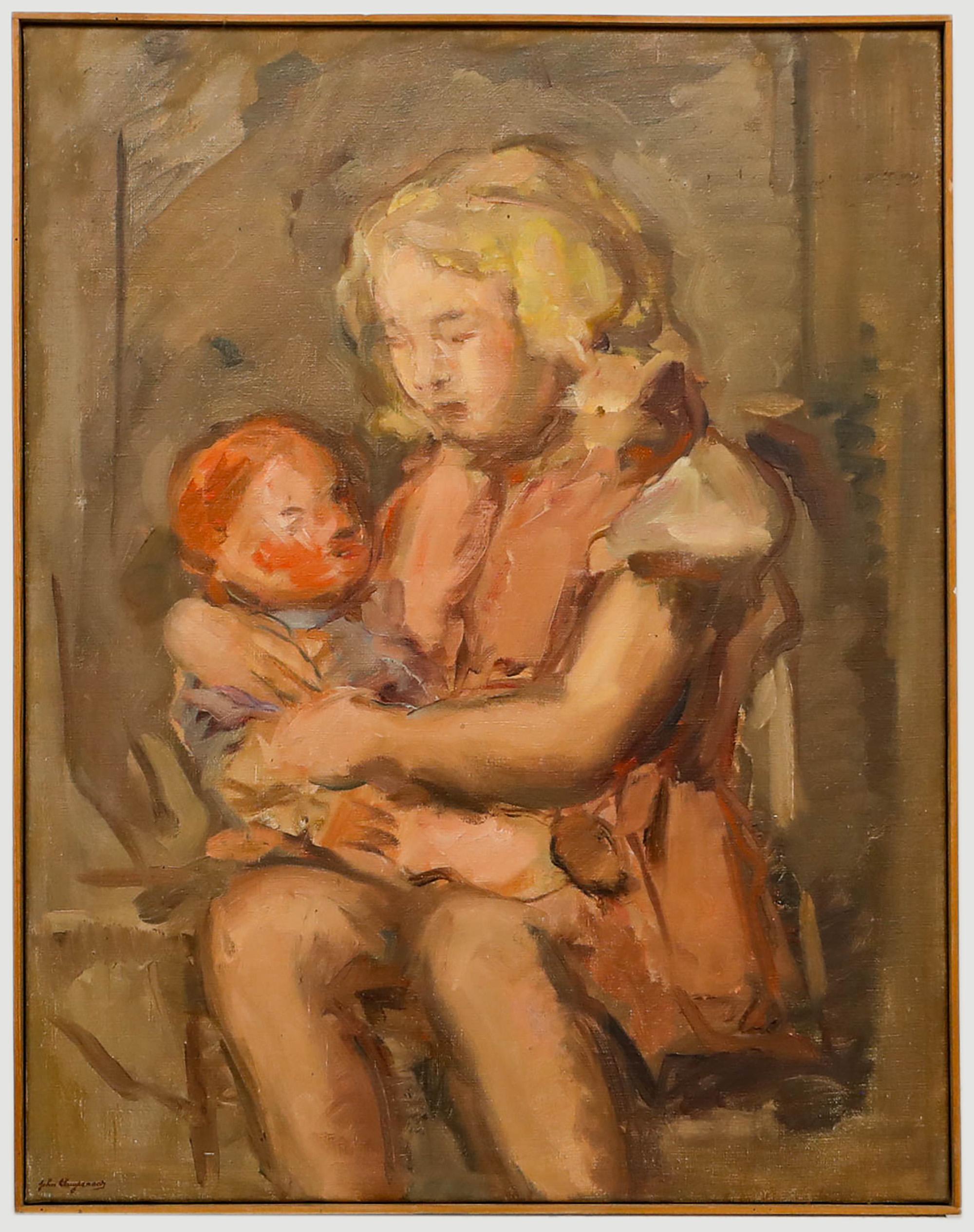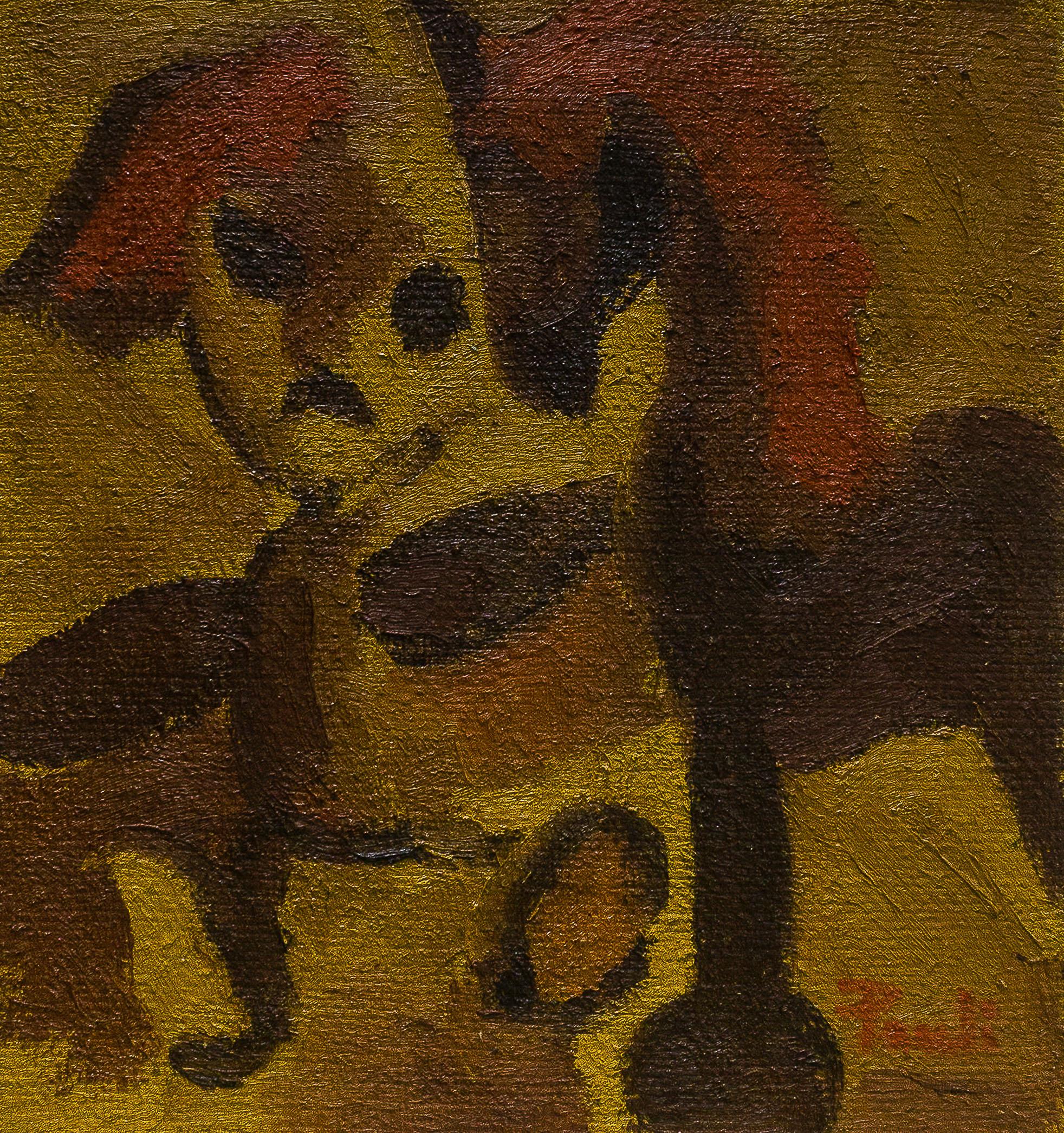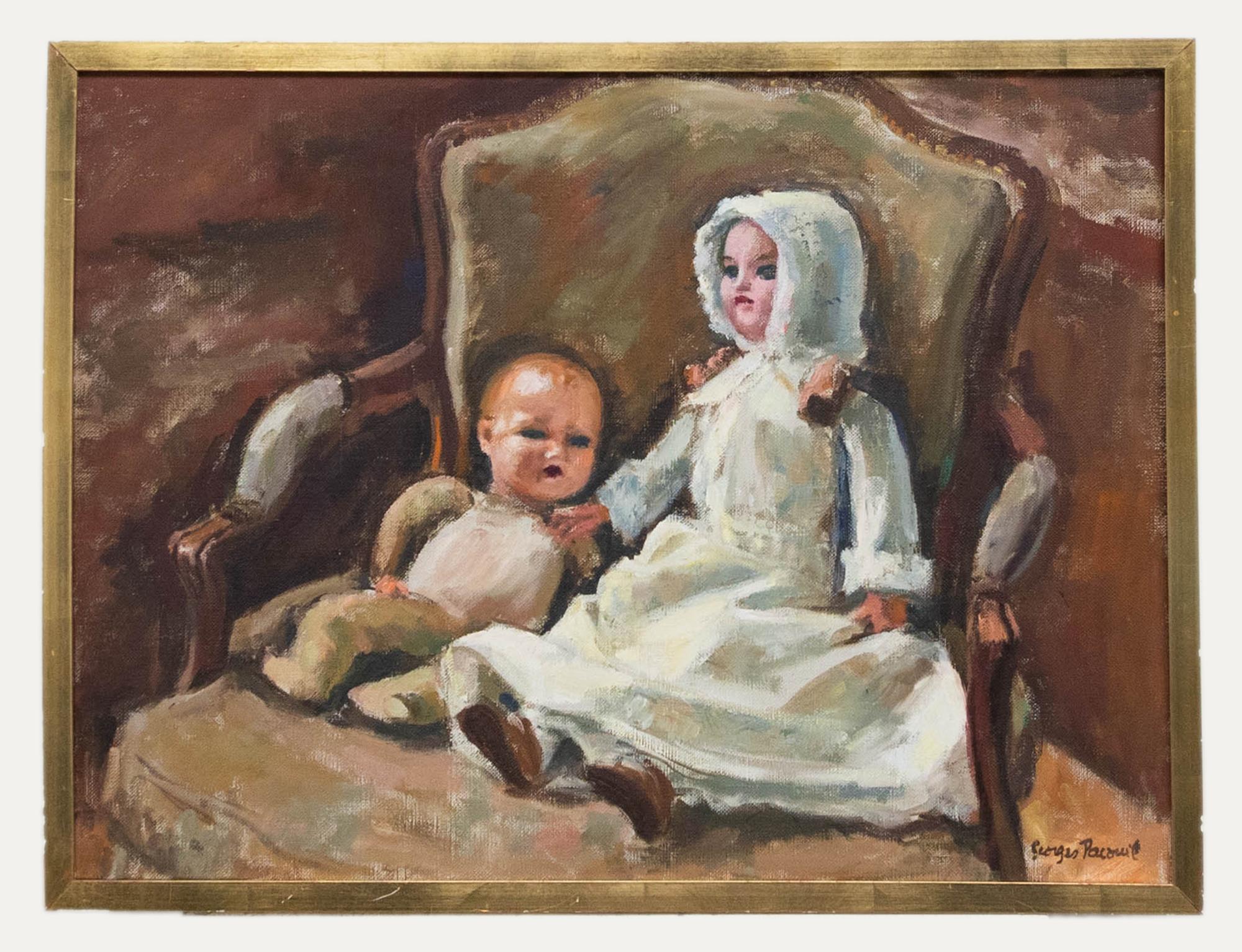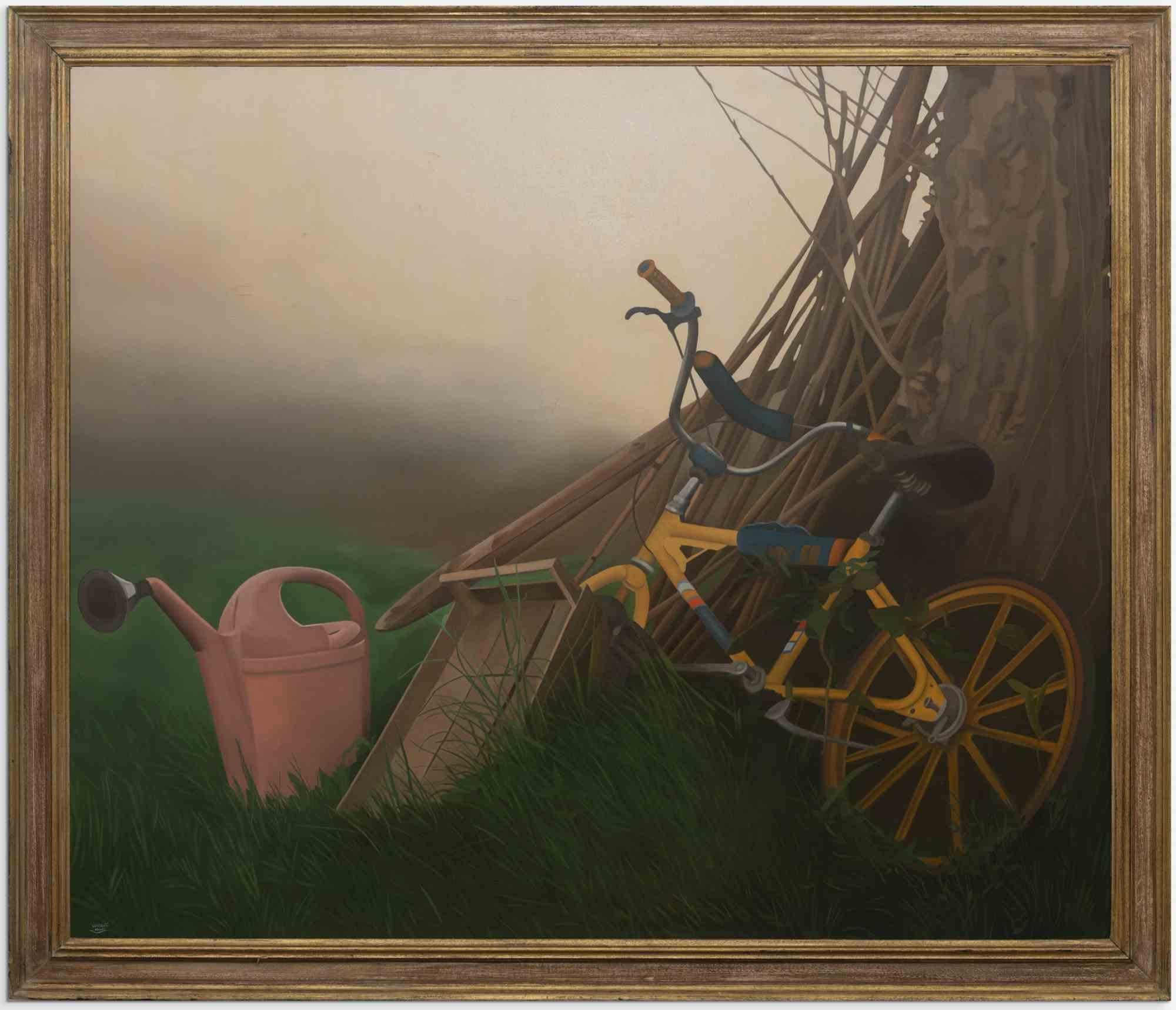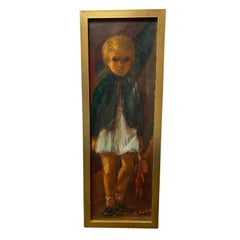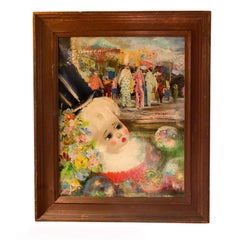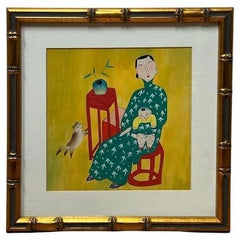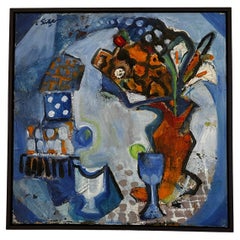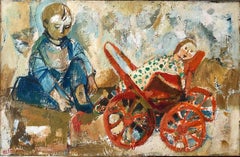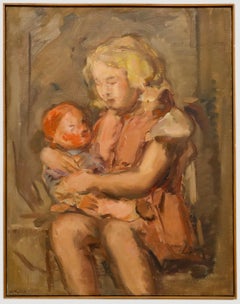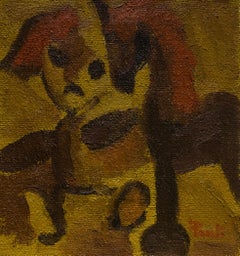Items Similar to " Tricycle and Doll" Oil on Canvas by Edgar Kiechle
Want more images or videos?
Request additional images or videos from the seller
1 of 11
Edgar Kiechle" Tricycle and Doll" Oil on Canvas by Edgar Kiechle1940s
1940s
$398.44
$1,60075% Off
£302.19
£1,213.5075% Off
€347.08
€1,393.7575% Off
CA$570.82
CA$2,292.2275% Off
A$628.43
A$2,523.5775% Off
CHF 321.19
CHF 1,289.8075% Off
MX$7,500.50
MX$30,119.4575% Off
NOK 4,089.47
NOK 16,421.9175% Off
SEK 3,826.83
SEK 15,367.2575% Off
DKK 2,592.48
DKK 10,410.5175% Off
About the Item
This figurative painting by Edgard Kiechle presents the scenario of a doll who is very surprised to have been abandoned into the basket of her mom's tricycle.
An interesting factor is the pictorial use of angles. The point of view, a little above the stage, probably that of an adult, offers particular perspectives. This approach adds depth to this painting with distinctive compositional appeal.
In contrast to the scene's disorder, a black-and-white tiled floor with a geometric design serves as an antithesis. The careful symmetry of the tiles competing with the surrounding disarray sparks a dialogue about the human need for organization and balance.
In composition, absence is a living element. The exclusion of a physical human figure amplifies the feeling of emptiness, creating a human presence perceived imaginatively.
Edgar O. Kiechle was born in 1911. He was a film illustrator and a painter.
Edgar studied landscape painting with Jean Mannheim and architecture and became an excellent watercolorist. After studying at the Otis Art Institute in Los Angeles, he interned with leading architects and designers. He worked at most major studios, but his career as an illustrator saw him primarily at the Universal Studio Art department.
In 1933, Edgar joined Lwerks as a background artist and worked on many films produced by Animated Picture Corporation through 1935.
In the summer of 1941, Edgar Kiechle joined the Universal Studio Art Department as an illustrator for motion pictures. His career as an illustrator saw him primarily at Universal.
He also produced hundreds of oil paintings. His first public showing was in an exhibition of motion picture artists in 1945. His work came to the attention of the motion picture colony, and many purchases were made by such notables of his day as Ida Lupino, Hedy Lamar, Helmut Dantine, Harry Warren, Georgie Hale, Jerome Kern, Ira Gershwin, and others. At that time, Herman Reuter wrote, "In the Kiechle canvasses, there is spirit, imagination, and dexterity of manipulation."
In addition, Kiechle’s oils appeared in various motion pictures, some of which were lent from Universal’s collection of Kiechle’s art.
Critic Herman Reuter wrote in the Hollywood Citizen-News that Kiechle''s "vigorous approach" was "especially notable in several oils," adding that his "bold layering on of paint seems to serve a definite expressive purpose, rather than being a mere mannerism as it so often is with those who mistake plastic tub-thumping for impressiveness."
In 1953, the distinguished art critic of the Los Angeles Times, Arthur Millier, called Kiechle "a born painter," saying that he had "a gift for suggesting atmosphere, and is one of the best painters of the night in the region."
In addition to one-man and invitational shows, Kiechle''s work has been included in exhibitions at the Los Angeles County Museum of Art, San Francisco Museum of Art, Oakland.
Edgar O. Kiechle died June 24, 1960, at the age of 49, but his vision of the world lives on in his work, which is exhibited in posthumous shows and hangs in numerous private collections.
- Creator:Edgar Kiechle (1911 - 1960, American)
- Creation Year:1940s
- Dimensions:Height: 28.75 in (73.03 cm)Width: 35 in (88.9 cm)Depth: 0.75 in (1.91 cm)
- Medium:
- Period:
- Condition:Cleaned and reframed.
- Gallery Location:Pasadena, CA
- Reference Number:1stDibs: LU654314067002
About the Seller
5.0
Vetted Professional Seller
Every seller passes strict standards for authenticity and reliability
Established in 1999
1stDibs seller since 2017
80 sales on 1stDibs
Typical response time: 1 to 2 days
- ShippingRetrieving quote...Shipping from: Pasadena, CA
- Return Policy
Authenticity Guarantee
In the unlikely event there’s an issue with an item’s authenticity, contact us within 1 year for a full refund. DetailsMoney-Back Guarantee
If your item is not as described, is damaged in transit, or does not arrive, contact us within 7 days for a full refund. Details24-Hour Cancellation
You have a 24-hour grace period in which to reconsider your purchase, with no questions asked.Vetted Professional Sellers
Our world-class sellers must adhere to strict standards for service and quality, maintaining the integrity of our listings.Price-Match Guarantee
If you find that a seller listed the same item for a lower price elsewhere, we’ll match it.Trusted Global Delivery
Our best-in-class carrier network provides specialized shipping options worldwide, including custom delivery.More From This Seller
View All"The Last Doll" Post-Impressionist Oil Portrait by Mary Erikson
By Mary Erickson
Located in Pasadena, CA
This miniature oil portrait by M. Erikson rises with verticality, like a fragment of life detached from the world. A child stands upright, yet her posture is far from rigid—it sugges...
Category
Late 20th Century Post-Impressionist Portrait Paintings
Materials
Oil
"The Doll and The Circus" Oil Portrait Painting by Santini Poncini
Located in Pasadena, CA
Some artists immediately stand out for the singularity of their work. Although little is known about the 20th-century French painter Santini Poncini, h...
Category
Mid-20th Century Impressionist Portrait Paintings
Materials
Oil
Post-Modern Gouache by Hu Yongkai
Located in Pasadena, CA
Hu Yongkai, born in Beijing in 1945, is currently a member of the Chinese Artists Association. He previously taught at the Shanghai Academy of Fine Arts and...
Category
Mid-20th Century Post-Modern Figurative Paintings
Materials
Gouache
Still-Life Blue Tones Oil on Canvas by Edward Sotello
Located in Pasadena, CA
With this oil painting realized by the Californian artist Edward Sotello, we can clearly see on the right a glass, a vase, and some flowers placed on a table. On the left, a possible...
Category
Mid-20th Century Expressionist Still-life Paintings
Materials
Canvas, Oil
$680 Sale Price
28% Off
"The Angel of Music " Modern Surrealist Oil Painting by Luis Alberto Solari
Located in Pasadena, CA
In The Angel of Music, Luis Alberto Solari presents a surreal, symbol-laden tableau where figuration and fantasy merge. At the center, a winged figure in a red cap floats horizontall...
Category
1970s Surrealist Figurative Paintings
Materials
Oil
"Naughty Children" on Canvas by Harold Stephenson, Aka Abruzzi
By Harold Stephenson
Located in Pasadena, CA
This painting features two children with big brown eyes peeking behind red-slatted shutters. The innocence on their faces contrasts with some sense of embarrassment, like if they had...
Category
1960s American Realist Figurative Paintings
Materials
Canvas, Oil
$600 Sale Price
50% Off
You May Also Like
Child with Doll and Buggy, Impressionist Oil Painting by Carlos Irizarry
By Carlos Irizarry
Located in Long Island City, NY
Artist: Carlos Irizarry
Title: Child with Doll and Buggy
Year: circa 1965
Medium: Oil on Canvas, signed l.r.
Size: 30 in. x 24 in. (76.2 cm x 60.96 cm)...
Category
1960s Expressionist Figurative Paintings
Materials
Oil, Canvas
Israeli Oil Painting Ruth Schloss Child, Doll, Wagon, Kibbutz Social Realist Art
By Ruth Schloss
Located in Surfside, FL
Large magnificent colorful Ruth Schloss oil painting of a child with a wagon with a doll or a baby in a carriage stroller.. Signed in Hebrew
size measures 31x43 with frame , 23x35.25 without the frame. (this is being sold unframed).
Ruth Schloss (22 November 1922 – 2013) was an Israeli painter and illustrator who mainly depicted neglected scenes such as Arabs, transition camps, children and women at eye-level as egalitarian, socialist view via social realism style painting and drawing.
Schloss became Israeli painting’s sensitive, conscious, remembering eye.
Ruth Schloss was born on 22 November 1922, in Nuremberg, Germany, to Ludwig and Dian Schloss, as the second of three daughters of bourgeois assimilationist Jewish family well-integrated into German culture. As the Nazis came into power in 1933, her family immigrated to Israel in 1937, and settled in Kfar Shmaryahu, then an agricultural settlement. Schloss studied at the Department of Schloss graphic design at "Bezalel" from 1938 to 1942 alongside Friedel Stern and Joseph Hirsch. She was a realistic painter who focused on disadvantaged people in the society and social matters as an egalitarian. Her realism was thus an “inevitable realism,” motivated by an inner necessity: the need to observe reality as it is.
Her painting repeatedly addressed the door pulled from its frame, employing drawing’s unique ability to stop time and prolong the image’s persistence in the retina, she repeatedly committed to paper - in a matter-of-fact, non-evasive manner devoid of mystery – man’s tendency to generate chaos, suffering and pain.
Throughout her life, Schloss remained minimalist. Painting about human fate was the main subject of her artworks. Her natural inclination was to describe the darker aspect of human existence.
1930s
The Schloss household was characterized by open, liberal spirit, in keeping with the parents’ progressive views. It deeply influenced Ruth’s mental development, as she learned to tie culture and art with sensitivity towards the weak and underprivileged.
In Jerusalem, she joined a commune of Hashomer Hatzair in which she shaped her socialist views, which she maintained throughout her long career.
1940s
In this period she mainly depicted landscapes of kibbutz and wretched women living hard life, children in huger, older people, refugees. After completing her art studies, Schloss joined a training group at Kibbutz Merhavia in 1942, and after two years moved to Karkur region, the nucleus established Kibutz Lehavot Habashan in the Upper Galilee. Through this time, she fell in love with the surroundings and drew landscapes. They are simple and direct with fresh, lucid lines. These paintings were selected as the main works of her first exhibition in 1949.
In early 1945, Schloss started to draw illustrations in the children’s magazine Mishmar Leyeladim, and designed the logo of Al Hamishmar, the paper’s new name in 1948. In 1948, upon the founding of Mapam (United Workers’ Party), she designed her party’s emblem, which became a well-known icon. She kept working as an illustrator for Mishmar Layeladim until 1949.
"Mor the Monkey" project yielded financial profits and this income was used for a study trip to Paris for two years. She was succesfull as illustrator however, she had inner conflicts of her identity as witnessed painter toward neglected class in Israeli society.
First Exhibition at Mikra-Studio Gallery, 1949
She presented forty drawings on paper in her first solo exhibition, representing a selection of the themes of kibbutz landscape, its lifestyle. Schloss confidently proposed her direction through simplicity without using colors in her drawings.
1950s
Between 1949 and 1951, she studied at the Académie de la Grande Chaumière in Paris.
She began working in oils, with which she continued throughout the 1960s.
The exhibition “Back from Paris” opened in November 1951 at Mikra-Studio Gallery .
In 1951 she married Benjamin Cohen, who served as chairman of the national leadership of Hashomer Hatzair Workers Party in Tel Aviv. He was a theoretician and a man of principle, highly esteemed by its leaders who became a professor of history at Tel Aviv University. In 1953, following the Mordechai Oren affair and the publication of Moshe Sneh 's followers from Kibbutz Artzi, she and her husband left the kibbutz and moved to the agricultural farm, Kfar Shmaryahu, where she lived until her death.
At a certain point in Israeli history, segments of the socialist movement felt that Israel should become part of the Communist bloc, rather than seek the support of the western world. Because the Schloss couple support of Moshe Sneh’s left-wing party, they had to leave the kibbutz.
She loved to depict ordinary women as figurative on her painting without hiding or making up anything. The poet Natan Zach wrote about her works in 1955: “Her motto remains that which has been all these years: life as it is, without bluffing."
Schloss’s “Pietà” (1953) became a universal cry expressing the pain of mothers on either side of the divide. In the late 1950s, she was the mother of two daughters. When she drew her daughters, unlike the universal babies she depicted, naked and with clenched fists, the painting of her children employed babyish sweetness to the full in a quiet, peaceful and heart-stirring filling rather than urgency. She also painted children in the transition camp and Jaffa in the 1950s and 1960s.
1960s-1980s – The period of Studio in Jaffa
Schloss painted at a studio in Jaffa from 1962 till 1983. In this time, she turned her interest to people around her more than kibbutz – the children, mothers, and poor workers, the alleys and houses. She opened the space to the street and its dwellings, built interactions around it, and was nurtured by the presence of the outside in her work.
1960s Schloss familiarized to an Arab woman, Nabava, lived in poor. Schloss returned to painting images of old people later, and she called her painting figurative elderly people in the old age homes “waiting”.
In the late 1960s, Ruth discovered acrylic paint and never turn back to oil painting.
In 1965 Schloss devoted a series “Area 9 (1965)”, dedicated to the demolition of Israeli-Arab houses and the expropriation of the land, and carried a definite socio-political messages. The series was exhibited at Beit Zvi, Ramat Gan, in 1966. She was the only artist who addressed the result of the Six-Day War immediately afterward. In 1968, Schloss and Gansser-Markus presented “Drawing of War” in Zurich gallery. She expressed the war as an ultimate expression of destruction and ruin, regardless of victors and vanquished.
1970s In late 1970s Schloss began printing the selected photograph directly on the canvas, posterior reworking it in acrylic. She decided to print her work at Har-El Printers in Jaffa, and these became the surface of her painting. This technique was mainly adopted in two large series: Anne Frank (1979-1980) and Borders (1982). Through this technique she placed the figure of elder Frank next to that of the famous young Frank, and released it at the exhibition at Bet Ariela Cultural Center, Tel Aviv, in 1981. The series touched upon the Nazi Holocaust.
1980s The Lebanon War raised the question of “The Good Fence” and the effect of the war. She dedicated a large series Boarders, one of the most powerful image linked to the series is the figure of Yemenite woman raising her hand. She was the first to raise the Black Panthers demonstration to the level of a social icon. In the 1980s and again in 2000, the Intifada uprisings also led Schloss to the easel to render a good number of representational and symbolic works that in their way denounced Israel's political and military actions.
1990s – 2000s Ruth Schloss never had an exhibition in a major Israeli museum. Her works were presented in private galleries and small museums. The main museums, the Tel Aviv Museum of Art and the Israel Museum, included her works only in group exhibitions, and only in 1991 was her retrospective exhibited at the Herzliya Museum.
In the 2000s, Schloss’s metaphors turned into animal kingdom and Bedouins in the south. A huge rhinoceros, birds of prey, and other "bad animals," as Cohen Evron, daughter of Ruth, calls them and "I connected this to the Nazis," said Schloss. Schloss' work after she didn't find human expression able to transmit the endless cruelty she saw in Israel's political mentality.
Schloss also continued to follow and collect documentary photographs of destructions of houses from the war, the Intifada, the sequence of her work about ruin from 1949 to 2005, was a cumulative testimony about the painful history of Israel and Palestine.
In 2006, a large retrospective exhibition of her work was presented at the Museum of Art in Ein Harod, curated by Tali Tamir.
Education
1938-41 Bezalel Art Academy, Jerusalem, with Mordecai Ardon
1946 painting course for Kibbutz Artzi artists with Yohanan Simon and Marcel Janco
1949-51 Académie de la Grande Chaumière, Paris
Awards and recognition
1965 Silver Medal, International exhibition in Leipzig, Germany
1977 Artist-in-Residence, The Cité Internationale Universitaire de Paris
Selected solo exhibitions
2004 “Micha...
Category
Mid-20th Century Realist Figurative Paintings
Materials
Canvas, Oil
John Cluysenaar (1899-1986) - Mid 20th Century Oil, Young Girl with Doll
Located in Corsham, GB
A fine oil by John Cluysenaar (1899-1986) depicting a young girl holding her doll. Presented in a wooden strip frame. Signed to the lower left. On canvas on stretchers.
Category
20th Century Portrait Paintings
Materials
Oil
Old toys by Gilbert Pauli - Oil on canvas 27x30 cm
By Gilbert Pauli
Located in Geneva, CH
Born in 1944 in the canton of Fribourg, Gilbert Pauli currently lives in Geneva, where he devotes himself to painting and sculpture, a passion he developed from his childhood. His fa...
Category
1990s Art Deco Figurative Paintings
Materials
Oil
$1,100 Sale Price
26% Off
Georges Pacouil (1903-1996) - Framed Mid 20th Century Oil, Dolls in an Armchair
Located in Corsham, GB
Signed to the lower right. Presented in a simple gilt-effect frame. On canvas on stretchers.
Category
20th Century Interior Paintings
Materials
Oil
$320 Sale Price
20% Off
The Bicycle - Oil Painting by Adolfo Lorenzetti - 1992
Located in Roma, IT
The Bicycle is a contemporary artwork realized by Adolfo Lorenzetti in 1992
Mixed colored oil painting on canvas.
Includes frame.
Hand signed on the lower margin.
some folds on t...
Category
1990s Contemporary Figurative Paintings
Materials
Oil
More Ways To Browse
Oil Painting Edgar
Black And White Tile
Vintage Black And White Tile
Edgar Kiechle
J Manning
Leda And The Swan Painting
Lindy Painted
Modern Paintings Of Women
Odalisque Paintings
Oil Paintings Of Angels
Painting Of Dove
Paintings By Garcia
Saint Sebastian
Sexual Paintings
Siren Painting
African Girl
Coal Miner
Egyptian Monuments
